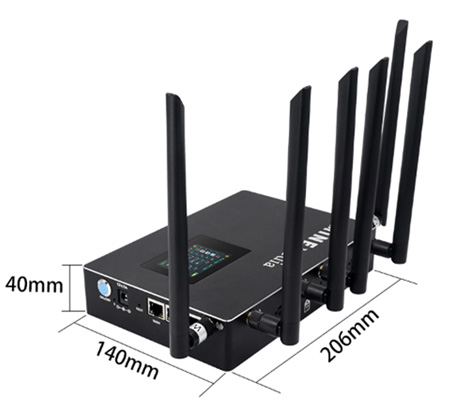The big comparison: HDMI vs. NDI transmission for multi-camera streams
You know the problem: you’re faced with a tangle of HDMI cables and wonder if there isn’t a more elegant

Wer als Livestream Profi arbeitet, kennt den Bedarf: Ausfallsicheres Internet mit Bonding über Mobilfunk. Wir vergleichen in diesem Beitrag zwei Geräte miteinander, die zwar nicht vergleichbar sind, aber dennoch in eine sehr ähnliche Richtung gehen: Der Peplink Balance 310 5G und die Peplink Alternative, der Mine Media M4 Mini.
Vorab: Es ist natürlich kein “amtlicher” Vergleich. Auch ist wichtig zu wissen, dass beide Geräte KEINE Encoder, sondern reine Bonding-Router sind. Auch sollte man wissen, dass die Geräte nur “bedingt” vergleichbar” sind: Der M4 Mini hat 4 eingebaute LTE-Modems und einen WAN-Ethernet-Port und 2 LAN-Ports.
Der Peplink hat ein 5G-Modem, ein LTE-Modem und einen USB-Port für einen Datenstick, einen WAN-Port und mehrere LAN-Ports. Der Durchsatz beträgt unverschlüsselt bis zu 600 Mbit/s und verschlüsselt bis zu 500 Mbit/s. Betrieben wird der Peplink mit den zwei mitgelieferten Antennen für LTE und einer 4×4 MIMO-Antenne für 5G.
Wer einen Bonding-Router sucht, um in der Pampa oder einer Location einen Internetaccess oder ein Backup zu haben, Leitungen bündeln zu können, aber keinen Encoder möchte, der ist mit beiden Geräten gut bedient.
Zu beiden Geräten ist eine Gegenstelle notwendig, die den gebündelten Traffic (mit öffentlicher IP) ins Netz übergibt. Der M4 Mini benutzt dazu einen Clouddienst, der bei Hetzner gehostet ist und von livestream-shop.com mit dem Gerät bereitgestellt wurde. Somit kann das Hosting in Deutschland, beim deutschen Anbieter gewährleistet werden.
Der Peplink benutzt für das Bonding z.B. AWS. Hier gibt es aber neben AWS auch “Images” für Hetzner, Azure und andere Anbieter. Für den M4 Mini gibt es eine Anleitung, um sich ggfs. diese Gegenstelle selber bauen zu können.
++ eingebauter Akku
++ einfache Bedienoberfläche
++ kein unnötiger Ballast in der GUI
++ für Anwendungen, wo es schnell gehen muss und kein weitergehendes Netzwerk-Verständnis da ist, gut geeignet
++ Farbdisplay mit allen wichtigen Infos – man erkennt sofort den Status
++ Koffer mit ordentlichem, gefrästem Inlay ist direkt dabei
++ eingebautes WiFi
— kein UDP
— kein NAT
Fazit: Wer einen TCP Router mit Bonding Internet für die typischen TCP Anwendungen und keine besonderen Netzwerk-Szenarien benötigt, findet mit dem M4 ein erstklassiges Gerät. Die eingebaut “USV” (Akku) macht den Router komplett mobil. Das Display bietet einen schnellen Überblick und der Benutzer weißt sofort und ohne ein Notebook starten zu müssen, woran er ist.
++ kann eine Menge an Netzwerkfunktionen – das bedeutet aber auch: man muss wissen, was man tut. Für Einsteiger ist er daher sicher nicht die erste Wahl
++ Netzwerkregeln, NAT sind möglich
++ UDP-Unterstützung
— kein Akku und damit nur bedingt mobil einsetzbar
— Koffer nicht im Lieferumfang dabei, als Extra lieferbar
— aktuell kein Rackmount verfügbar, soll aber wohl folgen
— kein Display
— im Vergleich zum Mine M4 “nur” 3 Modems (eins davon als USB-Device separat zu erwerben) möglich
— kein WiFi eingebaut
Fazit: Der Peplink Balance 310 5G ist eine Profigerät für Anwendungsfälle wie Backup, Filialvernetzung etc. gedacht. Damit verbunden, kann er Dinge, die ein “Normalo” beim Streamen vermutlich nie brauchen wird. Die vielen Einstellmöglichkeiten bergen daher auch immer das Risiko, dass man sich mit der Konfiguration selber einen Bock schießt. Wer also kein tiefergehenden Netzwerkwissen hat, ist mit dem Mine M4 besser dran.
Natürlich lassen sich beide Geräte nicht 1zu1 vergleichen, wer aber für den Einsatzzweck Livestream eine Alternative zum Peplink Balance 310 5G sucht ist mit dem Mine Media M4 absolut gut beraten.
You know the problem: you’re faced with a tangle of HDMI cables and wonder if there isn’t a more elegant
Reliable documentation of events is an immense challenge in many situations. In dynamic and often stressful situations, human perception reaches
As a content creator or entrepreneur, you know the problem: your audience is spread across different platforms. Your Twitch community